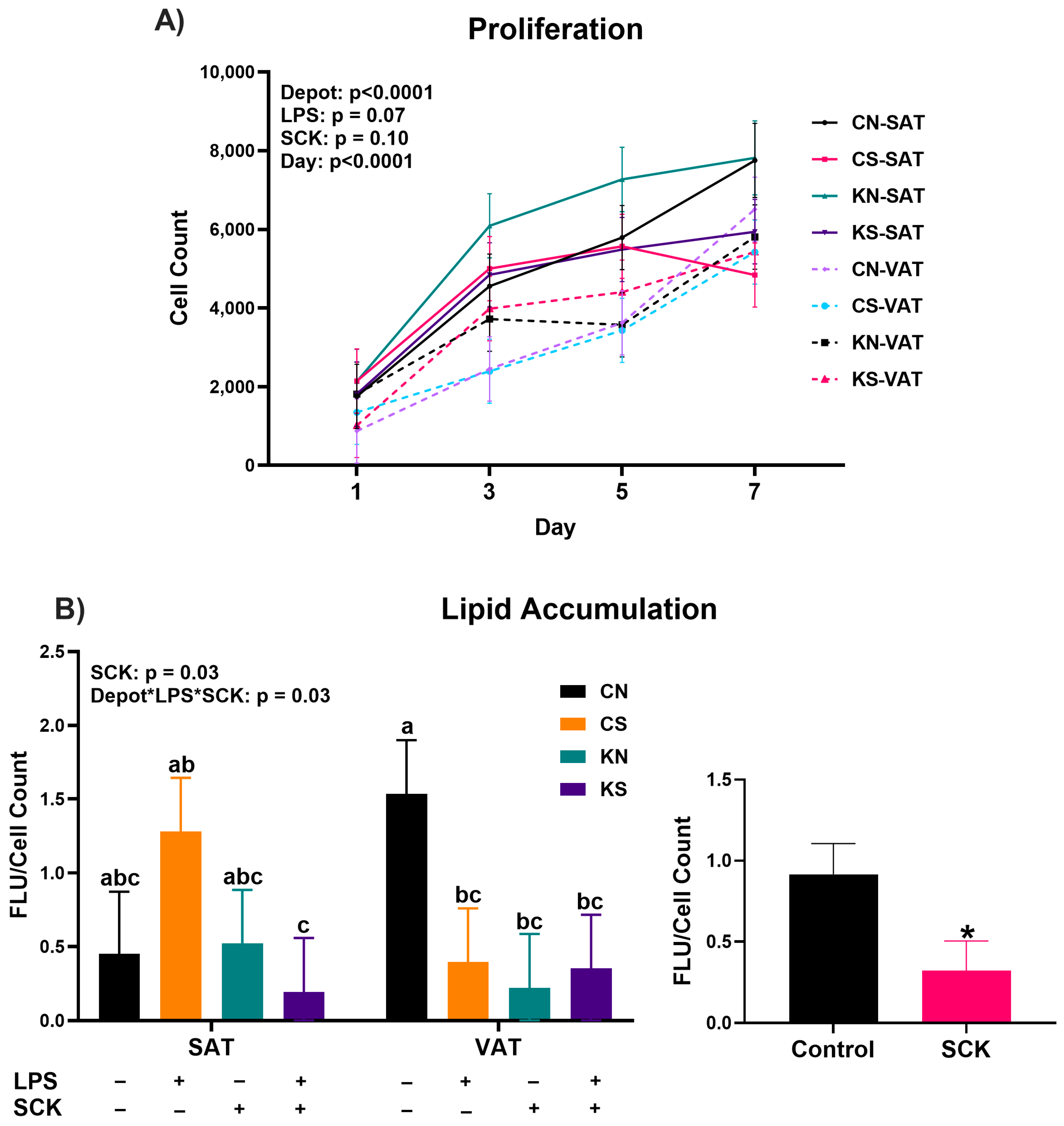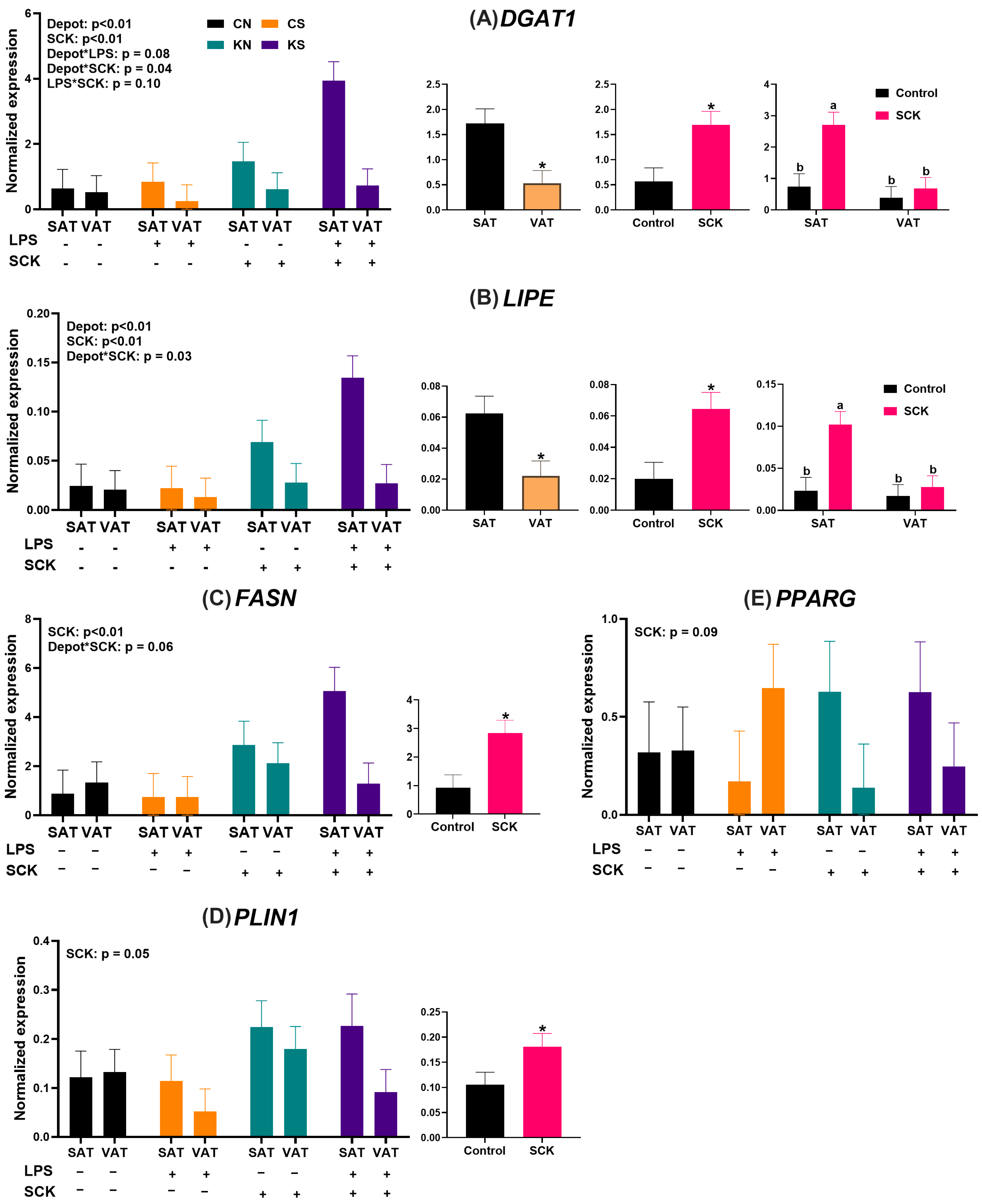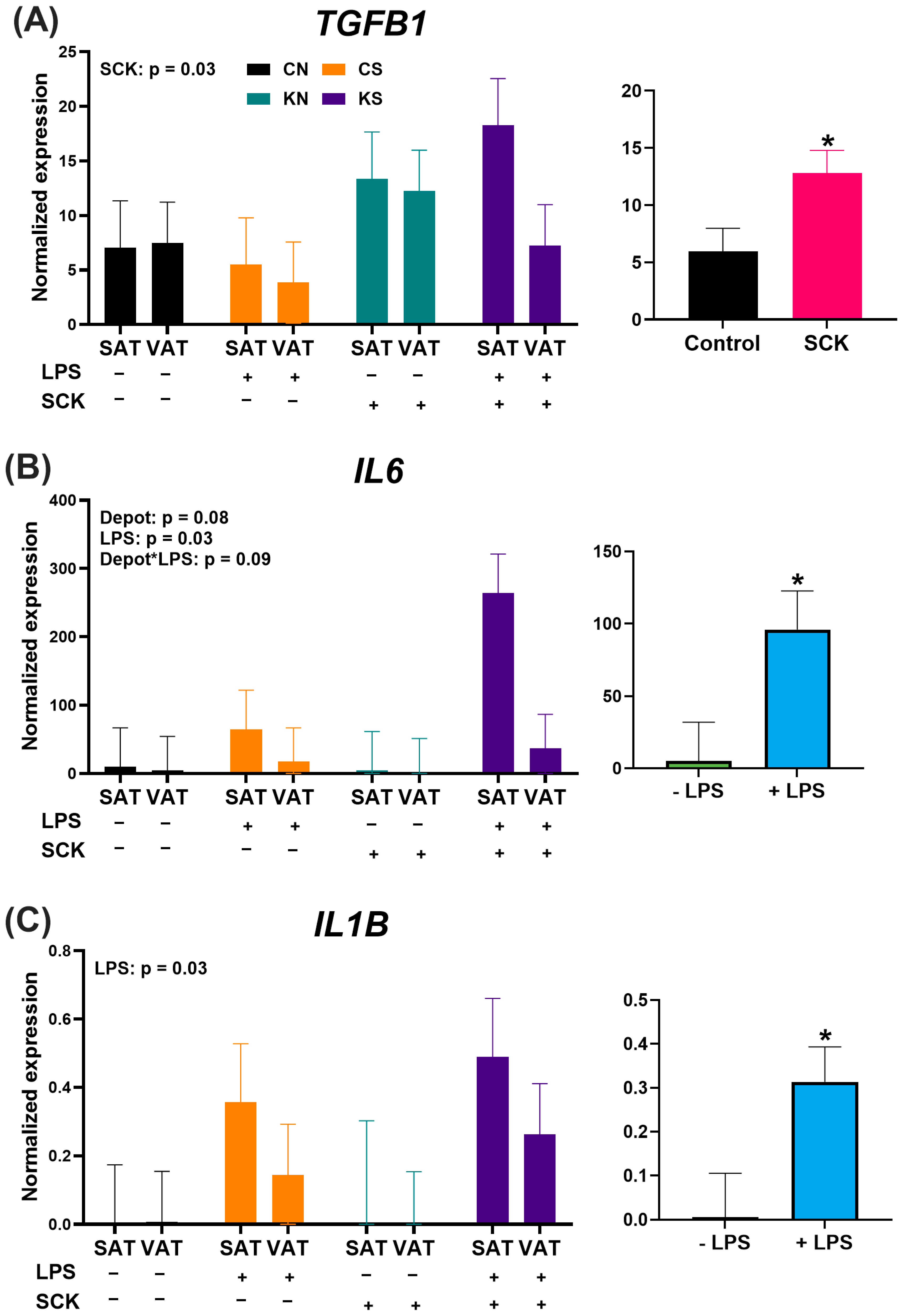The Effect of Subclinical Ketosis on the Peripheral Blood Mononuclear Cell Inflammatory Response and Its Crosstalk with Depot-Specific Preadipocyte Function in Dairy Cows
Abstract
:Simple Summary
Abstract
1. Introduction
2. Materials and Methods
2.1. Animals and Experimental Design
2.2. Blood Collection and Serum Metabolic Analysis
2.3. White Blood Cell Count
2.4. PBMC Isolation
2.5. Preparation of Conditioned Media
2.6. PBMC Cytokine Assessment
2.7. Adipose Tissue Collection and Digestion
2.8. Cell Culture
2.9. Preadipocyte Proliferation and Lipid Accumulation
2.10. Preadipocyte-PBMC Crosstalk
2.11. RTqPCR
2.12. Statistical Analysis
3. Results
3.1. Subclinical Ketosis Increased Circulating NEFA and BHB, but Decreased Total WBC and Neutrophils
3.2. Subclinical Ketosis Had a Minimal Effect on PBMC Expression of Target Genes
3.3. LPS Stimulation, but Not SCK, Affects IL-6 and TNFα Concentrations in PBMC-Conditioned Media
3.4. Preadipocytes Exposed to SCK PBMC-Conditioned Media Accumulate Less Lipids
3.5. Conditioned Media from SCK PBMCs Increases Expression of Genes Associated with Lipid Metabolism in Preadipocytes
3.6. Preadipocyte Cytokine Gene Expression Is Affected by LPS and SCK PBMC-Conditioned Media
4. Discussion
5. Conclusions
Supplementary Materials
Author Contributions
Funding
Institutional Review Board Statement
Informed Consent Statement
Data Availability Statement
Acknowledgments
Conflicts of Interest
References
- Wankhade, P.R.; Manimaran, A.; Kumaresan, A.; Jeyakumar, S.; Ramesha, K.; Sejian, V.; Rajendran, D.; Varghese, M.R. Metabolic and immunological changes in transition dairy cows: A review. Vet. World 2017, 10, 1367. [Google Scholar] [CrossRef] [PubMed]
- Bauman, D.E.; Currie, W.B. Partitioning of nutrients during pregnancy and lactation: A review of mechanisms involving homeostasis and homeorhesis. J. Dairy Sci. 1980, 63, 1514–1529. [Google Scholar] [CrossRef] [PubMed]
- Rutkowski, J.M.; Stern, J.H.; Scherer, P.E. The cell biology of fat expansion. J. Cell Biol. 2015, 208, 501–512. [Google Scholar] [CrossRef] [PubMed]
- Akter, S.; Häussler, S.; Dänicke, S.; Müller, U.; Von Soosten, D.; Rehage, J.; Sauerwein, H. Physiological and conjugated linoleic acid-induced changes of adipocyte size in different fat depots of dairy cows during early lactation. J. Dairy Sci. 2011, 94, 2871–2882. [Google Scholar] [CrossRef] [PubMed]
- Drackley, J.K.; Overton, T.R.; Douglas, G.N. Adaptations of glucose and long-chain fatty acid metabolism in liver of dairy cows during the periparturient period. J. Dairy Sci. 2001, 84, E100–E112. [Google Scholar] [CrossRef]
- Contreras, G.A.; Kabara, E.; Brester, J.; Neuder, L.; Kiupel, M. Macrophage infiltration in the omental and subcutaneous adipose tissues of dairy cows with displaced abomasum. J. Dairy Sci. 2015, 98, 6176–6187. [Google Scholar] [CrossRef] [PubMed]
- Després, J.-P.; Lemieux, I. Abdominal obesity and metabolic syndrome. Nature 2006, 444, 881–887. [Google Scholar] [CrossRef]
- Michelotti, T.C.; Kisby, B.R.; Flores, L.S.; Tegeler, A.P.; Fokar, M.; Crasto, C.; Menarim, B.C.; Loux, S.C.; Strieder-Barboza, C. Single-nuclei analysis reveals depot-specific transcriptional heterogeneity and depot-specific cell types in adipose tissue of dairy cows. Front. Cell Dev. Biol. 2022, 10, 1025240. [Google Scholar] [CrossRef]
- Ford, H.R.; Michelotti, T.; Strieder-Barboza, C. Single-nuclei RNA Sequencing of adipose tissue of dairy cows with subclinical ketosis. In Proceedings of the Conference of Research Workers in Animal Diseases, Chicago, IL, USA, 20–23 January 2024. [Google Scholar]
- Zeng, Y.; David, J.; Rémond, D.; Dardevet, D.; Savary-Auzeloux, I.; Polakof, S. Peripheral blood mononuclear cell metabolism acutely adapted to postprandial transition and mainly reflected metabolic adipose tissue adaptations to a high-fat diet in minipigs. Nutrients 2018, 10, 1816. [Google Scholar] [CrossRef]
- Kleiveland, C.R. Peripheral blood mononuclear cells. In The Impact of Food Bioactives on Health: In Vitro and Ex Vivo Models; Springer: Cham, Switzerland, 2015; pp. 161–167. [Google Scholar]
- Schulz, K.; Frahm, J.; Kersten, S.; Meyer, U.; Reiche, D.; Sauerwein, H.; Dänicke, S. Effects of elevated parameters of subclinical ketosis on the immune system of dairy cows: In vivo and in vitro results. Arch. Anim. Nutr. 2015, 69, 113–127. [Google Scholar] [CrossRef]
- Mann, S.; Sipka, A.S.; Grenier, J.K. The degree of postpartum metabolic challenge in dairy cows is associated with peripheral blood mononuclear cell transcriptome changes of the innate immune system. Dev. Comp. Immunol. 2019, 93, 28–36. [Google Scholar] [CrossRef] [PubMed]
- Cheng, Z.; Wylie, A.; Ferris, C.; Ingvartsen, K.; Wathes, D.C.; Consortium, G. Effect of diet and nonesterified fatty acid levels on global transcriptomic profiles in circulating peripheral blood mononuclear cells in early lactation dairy cows. J. Dairy Sci. 2021, 104, 10059–10075. [Google Scholar] [CrossRef]
- Surmi, B.K.; Hasty, A.H. The role of chemokines in recruitment of immune cells to the artery wall and adipose tissue. Vasc. Pharmacol. 2010, 52, 27–36. [Google Scholar] [CrossRef] [PubMed]
- Ferguson, J.D.; Galligan, D.T.; Thomsen, N. Principal descriptors of body condition score in Holstein cows. J. Dairy Sci. 1994, 77, 2695–2703. [Google Scholar] [CrossRef]
- Yamaguchi, T.; Yamanaka, M.; Ikehara, S.; Kida, K.; Kuboki, N.; Mizuno, D.; Yokoyama, N.; Narimatsu, H.; Ikehara, Y. Generation of IFN-γ-producing cells that recognize the major piroplasm surface protein in Theileria orientalis-infected bovines. Vet. Parasitol. 2010, 171, 207–215. [Google Scholar] [CrossRef]
- Kim, W.-S.; Ghassemi Nejad, J.; Roh, S.-G.; Lee, H.-G. Heat-shock proteins gene expression in peripheral blood mononuclear cells as an indicator of heat stress in beef calves. Animals 2020, 10, 895. [Google Scholar] [CrossRef]
- Strieder-Barboza, C.; de Souza, J.; Lock, A.L.; Contreras, G.A. Effect of prepartum adiposity and lipolysis on gestational and postnatal adipose tissue inflammation and immune cell infiltration. FASEB J. 2017, 31, 964.1. [Google Scholar] [CrossRef]
- Strieder-Barboza, C.; Contreras, G.A. Fetuin-A modulates lipid mobilization in bovine adipose tissue by enhancing lipogenic activity of adipocytes. J. Dairy Sci. 2019, 102, 4628–4638. [Google Scholar] [CrossRef]
- Doherty, R.; O’Farrelly, C.; Meade, K. Epigenetic regulation of the innate immune response to LPS in bovine peripheral blood mononuclear cells (PBMC). Vet. Immunol. Immunopathol. 2013, 154, 102–110. [Google Scholar] [CrossRef]
- Baird, G.; Hibbitt, K.; Hunter, G.; Lund, P.; Stubbs, M.; Krebs, H. Biochemical aspects of bovine ketosis. Biochem. J. 1968, 107, 683–689. [Google Scholar] [CrossRef]
- Mann, S.; McArt, J.A. Hyperketonemia: A Marker of Disease, a Sign of a High-Producing Dairy Cow, or Both? Vet. Clin. Food Anim. Pract. 2023, 39, 307–324. [Google Scholar] [CrossRef]
- Marutsova, V.; Binev, R.; Marutsov, P. Comparative clinical and haematological investigations in lactating cows with subclinical and clinical ketosis. Maced. Vet. Rev. 2015, 38, 159–166. [Google Scholar] [CrossRef]
- Choi, W.; Ro, Y.; Choe, E.; Hong, L.; Kim, D.; Kim, S.; Yoon, I.; Kim, D. Comparison of prepartum blood parameters in dairy cows with postpartum ketosis and new risk prediction candidates. Front. Vet. Sci. 2023, 10, 1161596. [Google Scholar] [CrossRef]
- Ha, S.; Kang, S.; Han, M.; Lee, J.; Chung, H.; Oh, S.-I.; Kim, S.; Park, J. Predicting ketosis during the transition period in Holstein Friesian cows using hematological and serum biochemical parameters on the calving date. Sci. Rep. 2022, 12, 853. [Google Scholar] [CrossRef] [PubMed]
- Suthar, V.; Canelas-Raposo, J.; Deniz, A.; Heuwieser, W. Prevalence of subclinical ketosis and relationships with postpartum diseases in European dairy cows. J. Dairy Sci. 2013, 96, 2925–2938. [Google Scholar] [CrossRef] [PubMed]
- Raboisson, D.; Mounié, M.; Maigné, E. Diseases, reproductive performance, and changes in milk production associated with subclinical ketosis in dairy cows: A meta-analysis and review. J. Dairy Sci. 2014, 97, 7547–7563. [Google Scholar] [CrossRef] [PubMed]
- Brodzki, P.; Kostro, K.; Brodzki, A.; Lisiecka, U.; Marczuk, J. Phenotyping of leukocytes and granulocyte and monocyte phagocytic activity in the peripheral blood and uterus of cows with endometritis. Theriogenology 2014, 82, 403–410. [Google Scholar] [CrossRef] [PubMed]
- Grönlund, U.; Johannisson, A.; Waller, K.P. Changes in blood and milk lymphocyte sub-populations during acute and chronic phases of Staphylococcus aureus induced bovine mastitis. Res. Vet. Sci. 2006, 80, 147–154. [Google Scholar] [CrossRef]
- Tsiamadis, V.; Kougioumtzis, A.; Siachos, N.; Panousis, N.; Kritsepi-Konstantinou, M.; Valergakis, G.E. Hematology reference intervals during the prepartum period, first week after calving, and peak lactation in clinically healthy Holstein cows. Vet. Clin. Pathol. 2022, 51, 134–145. [Google Scholar] [CrossRef]
- Mezzetti, M.; Bionaz, M.; Trevisi, E. Interaction between inflammation and metabolism in periparturient dairy cows. J. Anim. Sci. 2020, 98 (Suppl. S1), S155–S174. [Google Scholar] [CrossRef]
- Sordillo, L. Nutritional strategies to optimize dairy cattle immunity. J. Dairy Sci. 2016, 99, 4967–4982. [Google Scholar] [CrossRef] [PubMed]
- Pascottini, O.B.; Bruinjé, T.; Serrenho, R.C.; Mion, B.; LeBlanc, S. Association of metabolic markers with neutrophil function in healthy postpartum dairy cows. Vet. Immunol. Immunopathol. 2021, 232, 110182. [Google Scholar] [CrossRef] [PubMed]
- Lacetera, N.; Scalia, D.; Franci, O.; Bernabucci, U.; Ronchi, B.; Nardone, A. Effects of nonesterified fatty acids on lymphocyte function in dairy heifers. J. Dairy Sci. 2004, 87, 1012–1014. [Google Scholar] [CrossRef] [PubMed]
- Ster, C.; Loiselle, M.-C.; Lacasse, P. Effect of postcalving serum nonesterified fatty acids concentration on the functionality of bovine immune cells. J. Dairy Sci. 2012, 95, 708–717. [Google Scholar] [CrossRef] [PubMed]
- Hunter, C.A.; Jones, S.A. IL-6 as a keystone cytokine in health and disease. Nat. Immunol. 2015, 16, 448–457. [Google Scholar] [CrossRef]
- Li, C.-Y.; Liao, Y.-W.; Liu, C.-S.; Cheng, C.-Y.; Chan, J.P.-W.; Wang, C.-K. In vitro effects of nonesterified fatty acids and β-hydroxybutyric acid on inflammatory cytokine expression in bovine peripheral blood leukocytes. Ital. J. Anim. Sci. 2021, 20, 2197–2210. [Google Scholar] [CrossRef]
- Kaplanski, G. Interleukin-18: Biological properties and role in disease pathogenesis. Immunol. Rev. 2018, 281, 138–153. [Google Scholar] [CrossRef] [PubMed]
- Zamani, N.; Brown, C.W. Emerging roles for the transforming growth factor-β superfamily in regulating adiposity and energy expenditure. Endocr. Rev. 2011, 32, 387–403. [Google Scholar] [CrossRef]
- Choy, L.; Skillington, J.; Derynck, R. Roles of autocrine TGF-β receptor and Smad signaling in adipocyte differentiation. J. Cell Biol. 2000, 149, 667–682. [Google Scholar] [CrossRef]
- Richardson, R.; Campion, D.; Hausman, G.; Wright, J. Transforming growth factor type β (TGF-β) and adipogenesis in pigs. J. Anim. Sci. 1989, 67, 2171–2180. [Google Scholar] [CrossRef]
- Zhang, Z.; Meng, Y.; Gao, F.; Xiao, Y.; Zheng, Y.; Wang, H.-Q.; Gao, Y.; Jiang, H.; Yuan, B.; Zhang, J.-B. TGF-β1-mediated FDNCR1 regulates porcine preadipocyte differentiation via the TGF-β signaling pathway. Animals 2020, 10, 1399. [Google Scholar] [CrossRef] [PubMed]
- Roh, H.C.; Kumari, M.; Taleb, S.; Tenen, D.; Jacobs, C.; Lyubetskaya, A.; Tsai, L.T.-Y.; Rosen, E.D. Adipocytes fail to maintain cellular identity during obesity due to reduced PPARγ activity and elevated TGFβ-SMAD signaling. Mol. Metab. 2020, 42, 101086. [Google Scholar] [CrossRef] [PubMed]
- Eisinger, K.; Girke, P.; Buechler, C.; Krautbauer, S. Adipose tissue depot specific expression and regulation of fibrosis-related genes and proteins in experimental obesity. Mamm. Genome 2024, 35, 13–30. [Google Scholar] [CrossRef] [PubMed]
- van Dorland, H.A.; Sadri, H.; Morel, I.; Bruckmaier, R. Coordinated gene expression in adipose tissue and liver differs between cows with high or low NEFA concentrations in early lactation. J. Anim. Physiol. Anim. Nutr. 2012, 96, 137–147. [Google Scholar] [CrossRef] [PubMed]
- Ning, M.; Zhao, Y.; Li, Z.; Cao, J. Ketosis Alters Transcriptional Adaptations of Subcutaneous White Adipose Tissue in Holstein Cows during the Transition Period. Animals 2022, 12, 2238. [Google Scholar] [CrossRef] [PubMed]
- Ning, M.; Zhao, Y.; Dai, D.; Yao, C.; Liu, H.; Fang, L.; Wang, B.; Zhang, Y.; Cao, J. Gene co-expression network and differential expression analyses of subcutaneous white adipose tissue reveal novel insights into the pathological mechanisms underlying ketosis in dairy cows. J. Dairy Sci. 2023, 106, 5018–5028. [Google Scholar] [CrossRef] [PubMed]
- Holm, C.; Østerlund, T.; Laurell, H.; Contreras, J.A. Molecular mechanisms regulating hormone-sensitive lipase and lipolysis. Annu. Rev. Nutr. 2000, 20, 365–393. [Google Scholar] [CrossRef] [PubMed]
- Desgrouas, C.; Thalheim, T.; Cerino, M.; Badens, C.; Bonello-Palot, N. Perilipin 1: A systematic review on its functions on lipid metabolism and atherosclerosis in mice and humans. Cardiovasc. Res. 2024, 120, 237–248. [Google Scholar] [CrossRef] [PubMed]
- Brasaemle, D.L.; Levin, D.M.; Adler-Wailes, D.C.; Londos, C. The lipolytic stimulation of 3T3-L1 adipocytes promotes the translocation of hormone-sensitive lipase to the surfaces of lipid storage droplets. Biochim. Et Biophys. Acta (BBA)-Mol. Cell Biol. Lipids 2000, 1483, 251–262. [Google Scholar] [CrossRef]
- Cosentino, M.; Marino, F.; Bombelli, R.; Ferrari, M.; Rasini, E.; Lecchini, S.; Frigo, G. Stimulation with phytohaemagglutinin induces the synthesis of catecholamines in human peripheral blood mononuclear cells: Role of protein kinase C and contribution of intracellular calcium. J. Neuroimmunol. 2002, 125, 125–133. [Google Scholar] [CrossRef]
- Marino, F.; Cosentino, M.; Bombelli, R.; Ferrari, M.; Lecchini, S.; Frigo, G. Endogenous catecholamine synthesis, metabolism, storage, and uptake in human peripheral blood mononuclear cells. Exp. Hematol. 1999, 27, 489–495. [Google Scholar] [CrossRef] [PubMed]
- Musso, N.R.; Brenci, S.; Setti, M.; Indiveri, F.; Lotti, G. Catecholamine content and in vitro catecholamine synthesis in peripheral human lymphocytes. J. Clin. Endocrinol. Metab. 1996, 81, 3553–3557. [Google Scholar] [PubMed]
- Yu, H.; Gao, X.; Loor, J.J.; Jiang, Q.; Fang, Z.; Hao, X.; Shi, Z.; Fan, M.; Chen, M.; Li, X. Activation of Transcription Factor EB Is Associated with Adipose Tissue Lipolysis in Dairy Cows with Subclinical Ketosis. Front. Vet. Sci. 2022, 9, 816064. [Google Scholar] [CrossRef] [PubMed]
- Portillo, M.a.P.; Villaro, J.M.a.; Torres, M.a.I.; Macarulla, M.a.T. In vivo lipolysis in adipose tissue from two anatomical locations measured by microdialysis. Life Sci. 2000, 67, 437–445. [Google Scholar] [CrossRef] [PubMed]
- Queathem, E.D.; Welly, R.J.; Clart, L.M.; Rowles, C.C.; Timmons, H.; Fitzgerald, M.; Eichen, P.A.; Lubahn, D.B.; Vieira-Potter, V.J. White adipose tissue depots respond to chronic beta-3 adrenergic receptor activation in a sexually dimorphic and depot divergent manner. Cells 2021, 10, 3453. [Google Scholar] [CrossRef] [PubMed]
- Daval, M.; Foufelle, F.; Ferré, P. Functions of AMP-activated protein kinase in adipose tissue. J. Physiol. 2006, 574, 55–62. [Google Scholar] [CrossRef] [PubMed]
- Unamuno, X.; Gómez-Ambrosi, J.; Ramírez, B.; Rodríguez, A.; Becerril, S.; Valentí, V.; Moncada, R.; Silva, C.; Salvador, J.; Frühbeck, G. NLRP3 inflammasome blockade reduces adipose tissue inflammation and extracellular matrix remodeling. Cell. Mol. Immunol. 2021, 18, 1045–1057. [Google Scholar] [CrossRef]
- Wang, L.; Li, X.; Wang, Y. GSK3β inhibition attenuates LPS-induced IL-6 expression in porcine adipocytes. Sci. Rep. 2018, 8, 15967. [Google Scholar] [CrossRef]






| SCK | Control | p-Value ** | |
|---|---|---|---|
| DIM | 6.7 ± 3.8 | 8.1 ± 3.0 | 0.37 |
| Lactations | 3.2 ± 1.2 | 2.9 ± 1.4 | 0.62 |
| BCS (1–5) | 3.7 ± 0.4 | 3.8 ± 0.4 | 0.66 |
| BHB (mM) * | 1.5 ± 0.5 | 0.7 ± 0.1 | <0.01 |
Disclaimer/Publisher’s Note: The statements, opinions and data contained in all publications are solely those of the individual author(s) and contributor(s) and not of MDPI and/or the editor(s). MDPI and/or the editor(s) disclaim responsibility for any injury to people or property resulting from any ideas, methods, instructions or products referred to in the content. |
© 2024 by the authors. Licensee MDPI, Basel, Switzerland. This article is an open access article distributed under the terms and conditions of the Creative Commons Attribution (CC BY) license (https://creativecommons.org/licenses/by/4.0/).
Share and Cite
Ford, H.R.; Mitchell, T.M.; Scull, T.; Benitez, O.J.; Strieder-Barboza, C. The Effect of Subclinical Ketosis on the Peripheral Blood Mononuclear Cell Inflammatory Response and Its Crosstalk with Depot-Specific Preadipocyte Function in Dairy Cows. Animals 2024, 14, 1995. https://doi.org/10.3390/ani14131995
Ford HR, Mitchell TM, Scull T, Benitez OJ, Strieder-Barboza C. The Effect of Subclinical Ketosis on the Peripheral Blood Mononuclear Cell Inflammatory Response and Its Crosstalk with Depot-Specific Preadipocyte Function in Dairy Cows. Animals. 2024; 14(13):1995. https://doi.org/10.3390/ani14131995
Chicago/Turabian StyleFord, Hunter R., Ty M. Mitchell, Tanner Scull, Oscar J. Benitez, and Clarissa Strieder-Barboza. 2024. "The Effect of Subclinical Ketosis on the Peripheral Blood Mononuclear Cell Inflammatory Response and Its Crosstalk with Depot-Specific Preadipocyte Function in Dairy Cows" Animals 14, no. 13: 1995. https://doi.org/10.3390/ani14131995





